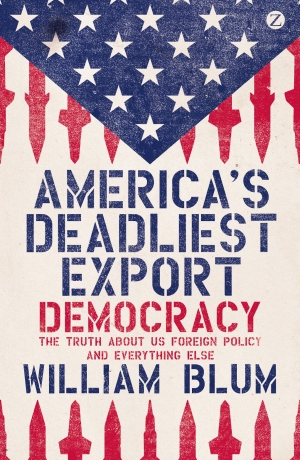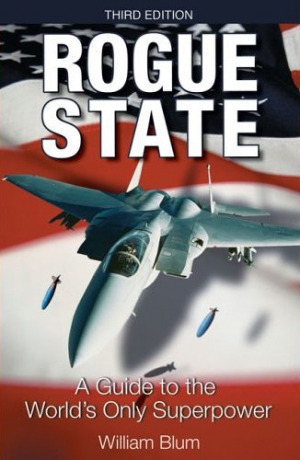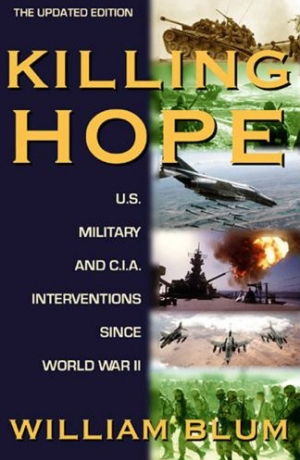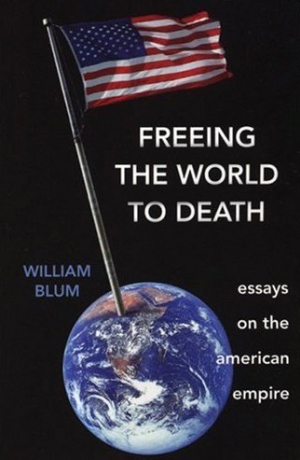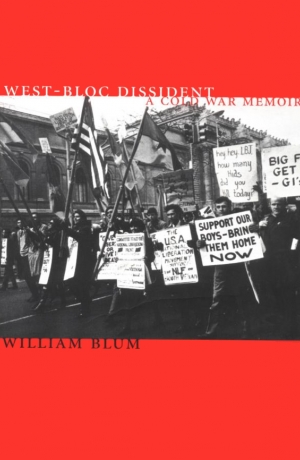United States bombings of other countries
It is a scandal in contemporary international law, don’t forget, that while “wanton destruction of towns, cities and villages” is a war crime of long standing, the bombing of cities from airplanes goes not only unpunished but virtually unaccused. Air bombardment is state terrorism, the terrorism of the rich. It has burned up and blasted apart more innocents in the past six decades than have all the antistate terrorists who ever lived. Something has benumbed our consciousness against this reality. In the United States we would not consider for the presidency a man who had once thrown a bomb into a crowded restaurant, but we are happy to elect a man who once dropped bombs from airplanes that destroyed not only restaurants but the buildings that contained them and the neighborhoods that surrounded them. I went to Iraq after the Gulf war and saw for myself what the bombs did; “wanton destruction” is just the term for it. – C. Douglas Lummis, political scientist 1
The above was written in 1994, before the wanton destruction generated by the bombing of Yugoslavia, another in a long list of countries the United States has bombarded since the end of World War II, which is presented below.
There appears to be something about launching bombs or missiles from afar onto cities and people that appeals to American military and political leaders. In part it has to do with a conscious desire to not risk American lives in ground combat. And in part, perhaps not entirely conscious, it has to do with not wishing to look upon the gory remains of the victims, allowing American GIs and TV viewers at home to cling to their warm fuzzy feelings about themselves, their government, and their marvelous “family values”. Washington officials are careful to distinguish between the explosives the US drops from the sky and “weapons of mass destruction” (WMD), which only the officially-designated enemies (ODE) are depraved enough to use. The US government speaks sternly of WMD, defining them as nuclear, chemical and biological in nature, and “indiscriminate” (meaning their use can’t be limited to military objectives), as opposed to the likes of American “precision” cruise missiles. This is indeed a shaky semantic leg to stand on, given the well-known extremely extensive damage to non-military targets, including numerous residences, schools and hospitals, even from American “smart” bombs, in almost all of the bombings listed below.
Moreover, Washington does not apply the term “weapons of mass destruction” to other weapons the US has regularly used, such as depleted uranium and cluster bombs, which can be, and often are, highly indiscriminate.
WMD are sometimes further defined as those whose effects linger in the environment, causing subsequent harm to people. This would certainly apply to cluster bombs, and depleted uranium weapons, the latter remaining dangerously radioactive after exploding. It would apply less to “conventional” bombs, but even with those there are unexploded bombs lying around, and the danger of damaged buildings later collapsing. But more importantly, it seems highly self-serving and specious, not to mention exceptionally difficult, to try to paint a human face on a Tomahawk Cruise missile whose payload of a thousand pounds of TNT crashes into the center of a densely-populated city, often with depleted uranium in its warhead.
A terrorist is someone who has a bomb but doesn’t have an air force.
The bombing list
- Korea and China 1950-53 (Korean War)
- Guatemala 1954
- Indonesia 1958
- Cuba 1959-1961
- Guatemala 1960
- Congo 1964
- Laos 1964-73
- Vietnam 1961-73
- Cambodia 1969-70
- Guatemala 1967-69
- Grenada 1983
- Lebanon 1983, 1984 (both Lebanese and Syrian targets)
- Libya 1986
- El Salvador 1980s
- Nicaragua 1980s
- Iran 1987
- Panama 1989
- Iraq 1991 (Persian Gulf War)
- Kuwait 1991
- Somalia 1993
- Bosnia 1994, 1995
- Sudan 1998
- Afghanistan 1998
- Yugoslavia 1999
- Yemen 2002
- Iraq 1991-2003 (US/UK on regular basis)
- Iraq 2003-2015
- Afghanistan 2001-2015
- Pakistan 2007-2015
- Somalia 2007-8, 2011
- Yemen 2009, 2011
- Libya 2011, 2015
- Syria 2014-2016
Plus
Iran, April 2003 – hit by US missiles during bombing of Iraq, killing at least one person 2
Pakistan, 2002-03 – bombed by US planes several times as part of combat against the Taliban and other opponents of the US occupation of Afghanistan 3
China, 1999 – its heavily bombed embassy in Belgrade is legally Chinese territory, and it appears rather certain that the bombing was no accident (see chapter 25 of Rogue State)
France, 1986 – After the French government refused the use of its air space to US warplanes headed for a bombing raid on Libya, the planes were forced to take another, longer route; when they reached Libya they bombed so close to the French embassy that the building was damaged and all communication links knocked out. 4
Philadelphia, Pennsylvania, May 13, 1985 – A bomb dropped by a police helicopter burned down an entire block, some 60 homes destroyed, 11 dead, including several small children. The police, the mayor’s office, and the FBI were all involved in this effort to evict a black organization called MOVE from the house they lived in.
Them other guys are really shocking
“We should expect conflicts in which adversaries, because of cultural affinities different from our own, will resort to forms and levels of violence shocking to our sensibilities.” – Department of Defense, 1999 5
The Targets
It’s become a commonplace to accuse the United States of choosing as its bombing targets only people of color, those of the Third World, or Muslims. But it must be remembered that one of the most sustained and ferocious American bombing campaigns was carried out against the people of the former Yugoslavia – white, European, Christians. The United States is an equal-opportunity bomber. The only qualifications for a country to become a target are:
- It poses a sufficient obstacle to the desires of the American Empire;
- It is virtually defenseless against aerial attack.
The survivors
A study by the American Medical Association: “Psychiatric disorders among survivors of the 1995 Oklahoma City bombing”:
Nearly half the bombing survivors studied had an active postdisaster psychiatric disorder, and full criteria for PTSD [posttraumatic stress disorder] were met by one third of the survivors. PTSD symptoms were nearly universal, especially symptoms of intrusive reexperience and hyperarousal. 6
Martin Kelly, publisher of a nonviolence website:
We never see the smoke and the fire, we never smell the blood, we never see the terror in the eyes of the children, whose nightmares will now feature screaming missiles from unseen terrorists, known only as Americans.
Notes
- The Nation, September 26, 1994, p.304
- RFE/RL Newsline, April 9, 2003 (Radio Free Europe/Radio Liberty is a “private” international communications service in Europe and Asia funded by the US government.)
- Washington Post, January 1, 2003; Australian Broadcasting Company, January 1, 2003; Agence France Presse, September 19, 2003
- Associated Press, “France Confirms It Denied U.S. Jets Air Space, Says Embassy Damaged”, April 15, 1986
- U.S. Commission on National Security/21st Century, “New World Coming” (Phase I Report), September 15, 1999, p.3
- Journal of the American Medical Association, August 25, 1999, p.761
This is a chapter from Rogue State: A Guide to the World’s Only Superpower by William Blum.
